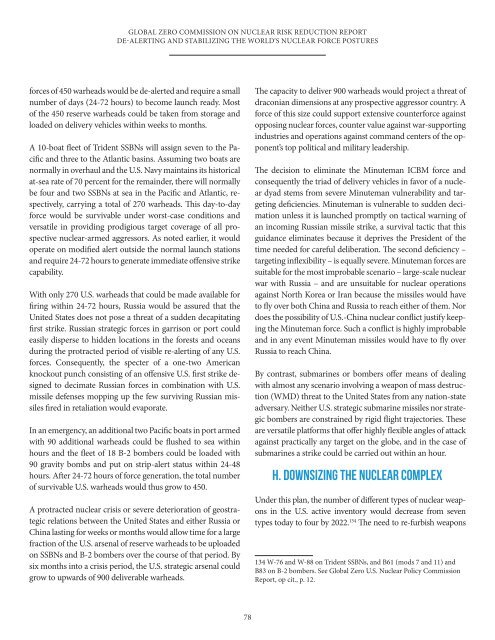global_zero_commission_on_nuclear_risk_reduction_report
global_zero_commission_on_nuclear_risk_reduction_report
global_zero_commission_on_nuclear_risk_reduction_report
You also want an ePaper? Increase the reach of your titles
YUMPU automatically turns print PDFs into web optimized ePapers that Google loves.
GLOBAL ZERO COMMISSION ON NUCLEAR RISK REDUCTION REPORTDE-ALERTING AND STABILIZING THE WORLD’S NUCLEAR FORCE POSTURESforces of 450 warheads would be de-alerted and require a smallnumber of days (24-72 hours) to become launch ready. Mostof the 450 reserve warheads could be taken from storage andloaded <strong>on</strong> delivery vehicles within weeks to m<strong>on</strong>ths.A 10-boat fleet of Trident SSBNs will assign seven to the Pacificand three to the Atlantic basins. Assuming two boats arenormally in overhaul and the U.S. Navy maintains its historicalat-sea rate of 70 percent for the remainder, there will normallybe four and two SSBNs at sea in the Pacific and Atlantic, respectively,carrying a total of 270 warheads. This day-to-dayforce would be survivable under worst-case c<strong>on</strong>diti<strong>on</strong>s andversatile in providing prodigious target coverage of all prospective<strong>nuclear</strong>-armed aggressors. As noted earlier, it wouldoperate <strong>on</strong> modified alert outside the normal launch stati<strong>on</strong>sand require 24-72 hours to generate immediate offensive strikecapability.With <strong>on</strong>ly 270 U.S. warheads that could be made available forfiring within 24-72 hours, Russia would be assured that theUnited States does not pose a threat of a sudden decapitatingfirst strike. Russian strategic forces in garris<strong>on</strong> or port couldeasily disperse to hidden locati<strong>on</strong>s in the forests and oceansduring the protracted period of visible re-alerting of any U.S.forces. C<strong>on</strong>sequently, the specter of a <strong>on</strong>e-two Americanknockout punch c<strong>on</strong>sisting of an offensive U.S. first strike designedto decimate Russian forces in combinati<strong>on</strong> with U.S.missile defenses mopping up the few surviving Russian missilesfired in retaliati<strong>on</strong> would evaporate.In an emergency, an additi<strong>on</strong>al two Pacific boats in port armedwith 90 additi<strong>on</strong>al warheads could be flushed to sea withinhours and the fleet of 18 B-2 bombers could be loaded with90 gravity bombs and put <strong>on</strong> strip-alert status within 24-48hours. After 24-72 hours of force generati<strong>on</strong>, the total numberof survivable U.S. warheads would thus grow to 450.A protracted <strong>nuclear</strong> crisis or severe deteriorati<strong>on</strong> of geostrategicrelati<strong>on</strong>s between the United States and either Russia orChina lasting for weeks or m<strong>on</strong>ths would allow time for a largefracti<strong>on</strong> of the U.S. arsenal of reserve warheads to be uploaded<strong>on</strong> SSBNs and B-2 bombers over the course of that period. Bysix m<strong>on</strong>ths into a crisis period, the U.S. strategic arsenal couldgrow to upwards of 900 deliverable warheads.The capacity to deliver 900 warheads would project a threat ofdrac<strong>on</strong>ian dimensi<strong>on</strong>s at any prospective aggressor country. Aforce of this size could support extensive counterforce againstopposing <strong>nuclear</strong> forces, counter value against war-supportingindustries and operati<strong>on</strong>s against command centers of the opp<strong>on</strong>ent’stop political and military leadership.The decisi<strong>on</strong> to eliminate the Minuteman ICBM force andc<strong>on</strong>sequently the triad of delivery vehicles in favor of a <strong>nuclear</strong>dyad stems from severe Minuteman vulnerability and targetingdeficiencies. Minuteman is vulnerable to sudden decimati<strong>on</strong>unless it is launched promptly <strong>on</strong> tactical warning ofan incoming Russian missile strike, a survival tactic that thisguidance eliminates because it deprives the President of thetime needed for careful deliberati<strong>on</strong>. The sec<strong>on</strong>d deficiency –targeting inflexibility – is equally severe. Minuteman forces aresuitable for the most improbable scenario – large-scale <strong>nuclear</strong>war with Russia – and are unsuitable for <strong>nuclear</strong> operati<strong>on</strong>sagainst North Korea or Iran because the missiles would haveto fly over both China and Russia to reach either of them. Nordoes the possibility of U.S.-China <strong>nuclear</strong> c<strong>on</strong>flict justify keepingthe Minuteman force. Such a c<strong>on</strong>flict is highly improbableand in any event Minuteman missiles would have to fly overRussia to reach China.By c<strong>on</strong>trast, submarines or bombers offer means of dealingwith almost any scenario involving a weap<strong>on</strong> of mass destructi<strong>on</strong>(WMD) threat to the United States from any nati<strong>on</strong>-stateadversary. Neither U.S. strategic submarine missiles nor strategicbombers are c<strong>on</strong>strained by rigid flight trajectories. Theseare versatile platforms that offer highly flexible angles of attackagainst practically any target <strong>on</strong> the globe, and in the case ofsubmarines a strike could be carried out within an hour.H. DOWNSIZING THE NUCLEAR COMPLEXUnder this plan, the number of different types of <strong>nuclear</strong> weap<strong>on</strong>sin the U.S. active inventory would decrease from seventypes today to four by 2022. 134 The need to re-furbish weap<strong>on</strong>s134 W-76 and W-88 <strong>on</strong> Trident SSBNs, and B61 (mods 7 and 11) andB83 <strong>on</strong> B-2 bombers. See Global Zero U.S. Nuclear Policy Commissi<strong>on</strong>Report, op cit., p. 12.78


